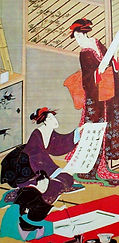Grade One - Children in Art
Lesson 5 –‘‘Children from other Times & Places - Costumes & Customs”
Art is made by people all around the world. Already this year in grade one we have looked at many different children who have been used as artists' subjects. Can you recall some of those paintings with children? Where did they come from? - Holland, England, France, Japan, - from across the Atlantic Ocean and from all around the world.
Today we will look at more children who live in far away places. They may also have lived a long time ago. Try to decide which paintings might have been portraits. Explore the picture for details about the customs or costumes of other places. Details also tell us about climate or weather. What do these children share with you today in the USA? How are they different?
Look for the clue in her clothing that tells us where this little girl lives. Except for her clothes, could this little girl and her friend live here on Cape Cod? Why is this painting called "The Helping Hand"?
MATERIALS
1. The Helping Hand, 1881 Emile Renouf, French (1845-1894)
Oil on canvas, The Corcoran Gallery of Art, Washington, DC


2. The Four Accomplishments, Toyohiro, Japanese(1763-1828)
Woodcut prints, Ukiyo-e School, Freer Gallery, Washington, DC
A most graceful artist whose works have much poetic feeling. He studied in the Utagawa school and in turn had many students in his own school.
"The Four Accomplishments" include two prints with two accomplishments on each print. In an earlier lesson we saw a girl playing a harp-like instrument called a "koto". A boy in the background was playing a game similar to Backgammon. This lesson we will see the other two accomplishments - calligraphy and painting. In Oriental art, calligraphy, painting and poetry go together. In calligraphy, word and image are inseparable. While the characters serve a text, many characters have a pictographic quality. Painting depended upon mastery of brush and feeling for ink that were usually gained through an understanding of the pictorial demands and possibilities of words.
In the Edo period, decorative painting continued while a unique style of genre painting evolved, known as Ukiyo-e. Ukiyo-e art, for the most part, is celebratory. It features colorful images of daily life, fashionable courtesans and actors from the popular Kabuki theatre. These paintings were later adapted to the wood-cut process. By the end of the era, multi-colored prints were being produced by over 200 artists and marketed to the middle class at very low prices.
The Four Accomplishments
The four accomplishments are qin (the guqin, a stringed instrument), qi (the strategy game of Go), shu (calligraphy) and hua (painting).

3. Suzuri Set (in portfolio)
Sumi set contains two brushes, a Sumi stick, and a Suzuri stone. These are the instruments used for traditional Sumi-E art. Sumi art is Chinese in origin and is used in calligraphy and painting.

Find the toy in this painting. What do you think it is made of? This is Henry VIII's son. What else tells you he is the son of a king? Have you ever seen a baby sitting up in such a regal pose? He holds his rattle just as a king would hold his sceptre. Hans Holbein could paint the surface of things perfectly. "Feel" the textures of the prince's clothes with some words to describe them. He probably painted Edward just as he looked, with no flattery.
The inscription in Latin at the bottom of the painting does flatter the king however:
"Little One, emulate thy father: be heir to the virtue of him whose equal the world does not possess. heaven and earth could hardly produce a son to surpass in glory such a father. Do but match in full thy parent's deeds, and men could ask no more. Shouldst thou surpass him, thou hast outstripped all kings the world revered in ages past."
Edward VI died at the age of 16 and never lived up to such grand expectations. That was left to his older sister, Elizabeth I.
Hans Holbein, the younger was born in Augsburg, Germany and studied with his artist father. He later went to paint in Basl and met a lifelong friend Erasmus, the famous philosopher. Through Erasmus he met Sir Thomas More, an official in the English court. He was soon painting the king himself and his family in his realistic style.

5. The Gourmet, 1901, Pablo Picasso, Spanish (1881-1973)
Oil on canvas, Private Collection
In "The Gourmet", this little girl also probably lives in a poor peasant family. What color is predominant? Why do you think that Picasso picked blue and then painted everything with a blue tinge? Does the color suggest a cool climate? Why? Why does she wear boots? A gourmet is a connoisseur of food and drink. Why do you think that Picasso chose that title for his painting? Notice her warm red cheeks. Where else do you see a hint of that color?
Picasso inspired nearly every important artistic movement in the 20th century. He painted the poor of Paris mostly in blue tones, then in rose. African art inspired him to explore broken forms and planes and to try Cubism. His painting also was an echo of his times with comments on wars, revolutions and new technologies. On the other hand, the paintings are universal.


6. Boston Common at Twilight, 1885-86, Childe Hassam, American (1859-1935) Oil on canvas 42”x60”, Museum of Fine Arts, Boston
Hassam was an American Impressionist painter and an etcher. He was born in Boston and studied in Paris, returning to the USA in 1889. He settled in New York.
Horse drawn trolley shows the historical scene. Snow shows the season. Light shows the time of day. Notice the emphatic use of linear perspective.
Additional Links: More of Hassam's work

